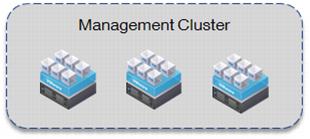3.2 Compute Layer
The management cluster compute layer encompasses the CPU, memory, and hypervisor technology components. Follow vSphere design guidelines when configuring and sizing compute resources.
Figure 5. Three-Host Management Cluster
Use a three-host cluster to support vCloud management components. Add additional hosts if the management cluster becomes resource-constrained.
Enable VMware vSphere High Availability and DRS on the management cluster to provide availability for all management components. For vSphere HA, use the Percentage as cluster resources reserved admission control policy in an N+1 fashion instead of defining the number of host failures a cluster can tolerate or specifying failover hosts. This allows management workloads to run evenly across the hosts in the cluster without the need to dedicate a host strictly for host failure situations. For higher availability, you can add an additional host for an N+2 cluster.
The vCloud Director-managed vCenter Server instances play an integral role in end-user, self-service provisioning by handling all virtual machine deployment requests from vCloud Director. VMware recommends increasing the availability of vCenter Server using solutions such as VMware vCenter Server Heartbeat.
VMware vSphere Fault Tolerance can be used for continuous virtual machine protection only if all
FT requirements are met. vCenter Site Recovery Manager can be used to protect
components of the management cluster
against site failure. See Appendix C: vCloud Suite Disaster Recovery for details.
vCloud Director 5.1 supports vSphere 5.0 and later. Deploy vSphere 5.1, if possible, to take advantage of the new features. Some functionality in vCloud Director requires specific features and requires particular vSphere editions. For example, automated deployment of vCloud networks requires a distributed switch, which is supported in the VMware vSphere Enterprise Plus Edition™.

